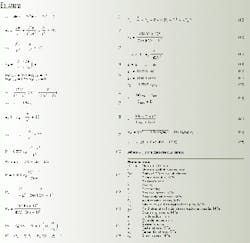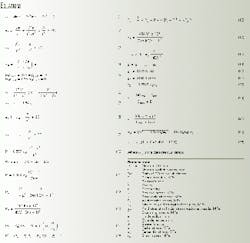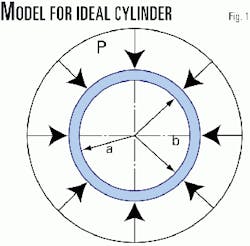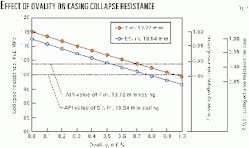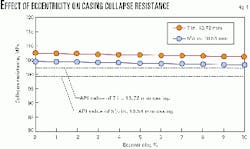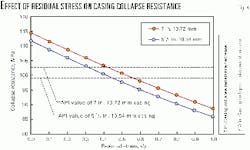Collapse-resistance values for special casing that undergoes external deformation can be calculated with new pressure equations developed by the Southwest Petroleum Institute, China.
These equations can be used for high-collapse resistance casing, non-API standard pipe, and casing with abnormal wall thickness.
Up to this point, the industry has not developed standard calculations for specially manufactured casing that uses a special wall thickness to overcome high collapse regimes. According to the theory of elasticity and plasticity, an equation for the estimation of the collapse resistance for non-API casing has been obtained and modified later in consideration of casing manufacturing imperfections.
The equations involve base dimensions, minimum yield strength, ovality, eccentricity, residual stress, and axial stress.
The model and software have been verified by the test data coming from Tubular Goods Research Center and Tianjin Pipe Corp. of China. Research shows that the model has great importance in theoretical research, field application, and casing manufacturing quality.
To illustrate the reliability and universality of the equations in this article, the equations have been used to calculate the collapse resistance for API standard casing with certain manufacturing imperfections. These calculations remain consistent with API standards.
Introduction
API collapse-pressure equations are based on a large number of casing-collapse test data applied worldwide. Among the four collapse-pressure equations, both the plastic-collapse pressure equation and the transition-collapse pressure equation, which are derived by statistical regression analysis from collapse tests, provide primary inputs.
In fact, tubular-goods quality and tube-body imperfections differ from manufacturer to manufacturer. With advancements in casing manufacturing technology, however, imperfections of high-collapse resistance casing can be strictly controlled. Nevertheless, the industry has established no standards for new casing types.
Using the theory of elasticity and plasticity, an equation for the estimation of the collapse resistance for an ideal round tube has been obtained and modified in consideration of casing manufacturing imperfections.
Ideal roundness
Casing, cement mantle, and formation consolidate once the pipe is cemented in place. According to the theory of elasticity and plasticity, this kind of problem can be dealt with as a plane-strain problem performed through singular analyses of the casing and cement mantle.
Suppose the casing is an ideal round cylinder with uniform wall thickness where the stress function can be shown by Equation 1 (see Equation box, Fig. 1).
Because the casing is a multiple-connected body, all of its displacements are single valued. It can then be proved that the item Br2 ln r in the stress function must be equal to zero (Equations 2-4), with the boundary conditions stipulated by Equation 5.
Then, it becomes possible to determinine the coefficients A and C in the stress function from the boundary conditions (Equation 6). There are two ways to determine the casing-collapse pressure-elastic instability and plastic yielding.2
For plastic yielding, engineers use the Von Mises Criterion in which the stress distribution is considered elastic up to the point of yielding. For casing sizes that range from 5 to 95/8 in., most diameter-to-wall-thickness (D/t) ratios lie between 10 and 25. Thus, Von Mises plastic yielding shows a more representative view and will be used in the following methodology (Equation 7).2
Plastic yielding first occurs at the internal wall of casing. Applying the boundary conditions of r = a into Equations 2 and 3, we obtain Equations 8 and 9. Then substituting Equations 8 and 9 into Equation 7, we obtain Equation 10. In this way, the term a and b can be eliminated in Equation 10 in order to obtain Equation 11.
It is worthwhile to note that the value 2.308 in Equation 11 is used here. In API-standard documents, the coefficient of 2.00 is used instead.
Casing imperfections
Calculations show that values obtained from Equation 11 are higher than test values. According to the D/t ratio, the onset of casing collapse under external pressure can occur either through yield-strength collapse or instability.
Additionally, the casing does not form a perfectly round cylinder, but instead some imperfections such as ovality, eccentricity, and residual stress are induced through external forces such as axial tension. Thus, Equation 11 must be modified.
In 1937, W.O. Clinedinst developed a theoretical elastic collapse pressure equation that can be used here (Equation 12).3 Assuming E is equal to 207,000 MPa, and ¶µ is equal to 0.3, we obtain Equation 13.
Research shows that the relation shown in Equations 14 and 15 might be assumed between the measured pressure and the theoretical values of the corresponding ideal pipe.4
Solving these equations, we obtain Equation 16 as supported by Equations 17-24. In general, ovality and eccentricity remain positive, while the residual stress becomes negative due to compressive stresses. Thus, these imperfections increase the parameter g while decreasing the real collapse pressure.
Test data
In relation to commercial API casing, Tianjin Pipe Corp. of China has developed 95/8-in. P110 high-collapse pressure casing with an 11.99-mm WT for deep-well environments. To estimate collapse resistance for this heavy-wall pipe, Tubular Goods Research Center and Tianjin Pipe Corp. of China tested nine commercial casing strings as test samples by cutting each in half and conducting collapse tests (Table 1).
Engineers then compared the empirical test data with values obtained from Equation 16 (Table 2). As a result, they saw empirical collapse resistance values 30% higher than those found with API collapse-pressure calculations. On the other hand, these physical test values remained consistent with those found in Equation 16.
Thus, it can be shown that axial tension stresses (two-axial stress calculation) must be accounted for in the design of a casing string. The yield strength of axial stress equivalent grade can be shown in Equation 25.3 This calculation shows that casing collapse resistance decreases while axial tension stress increases in the range of plastic collapse (Table 3).
API comparison
Table 4 shows comparative data for 5 1/2, 7, and 9 5/8-in. casing. According to API standard, casing OD tolerance is [-0.5, +1.0] while wall-thickness tolerance is no more than 12.5%. It does not specify residual stress tolerance, however.
The best range of residual stress can be related to the minimum yield strength of the pipe and the casing D/t ratio. The higher the D/t ratio, the higher the residual stress. By looking at the averages of ovality and eccentricity respectively in the calculation, it can be seen that eccentricity is 5% when the residual stress value is obtained through Equation 26.
The base residual stresses of different manufacturers are not the same as different steel chemistries, augmented by processes of rolling and heat treatment, that serve to alter the physical nature of the pipe. In general, high-tensile steel has high-base residual stress levels while low-tensile steel has low base residual stress values.
For calculations used in this article, common base residual stresses for typical grades commonly are as follows:
J55, srb = 80MPaN80, srb = 130MPaP110, srb = 200MPaSubstituting Equation 26 into Equation 22, the relative residual stress of commercial API standard casing can be calculated. Then it becomes possible to estimate the collapse resistance for these casings using Equation 16, which can then be compared with API values (Table 4).
Table 5 also shows comparative data for 5 1/2 and 7-in. casing. By evaluating parameter sensitivities for casing imperfections that can affect collapse resistance, it becomes obvious that the factors that decrease the collapse resistance of casing, in order, include residual stress, then ovality, and finally eccentricity (Equation 16, Figs. 2-4).
This conclusion provides great value for well construction engineers in their efforts to select the best casing grades as well as for manufacturers to improve the quality of casing.
References
- Xu Zhilun, Theory of Elasticity, People's Education Press, Beijing, 1990.
- EI-Sayed, A.H., Khalaf, F., "Resistance of Cemented Concentric Casing Strings under Non-uniform Loading," SPE paper 17927, SPE Drilling Engineering, March 1989.
- Bulletin on Formulas and Calculations for Casing, Tubing, Drill Pipe, and Line Pipe Properties. API Bulletin 5C3, 6th Edition, 1994.
- Tamano, T., Mimaki, T., Yanagimoto, S., "A New Empirical Formula for Collapse Resistance of Commercial Casing," R&D Products Laboratories, Nippon Steel Corp., Kanagawa, Japan.
- Yang Yong, Zhang Yi, "Research of TP-110T Casing Collapse Tests-Special Tube for Petroleum," Vol. 4, pp. 25-31, 1996.
The authors
Han Jianzeng is a doctoral postgraduate at Petroleum Engineering Department in Southwest Petroleum Institute (SWPI), Nanchong City, Sichuan Province, China. His work involves research on the new technology and theory of drilling engineering. He holds a BS and MS in oil and gas storage and transportation engineering from Southwest Petroleum Institute.
Shi Taihe is a professor at the Petroleum Engineering Department in Southwest Petroleum Institute (SWPI), Nanchong City, Sichuan Province, China. His work involves research and teaching on the new technology and theory of drilling engineering. He holds a BS in drilling engineering from Petroleum University of China and is a member of SPE.
